Beautifully Designed Restaurants Use Commercial LVT
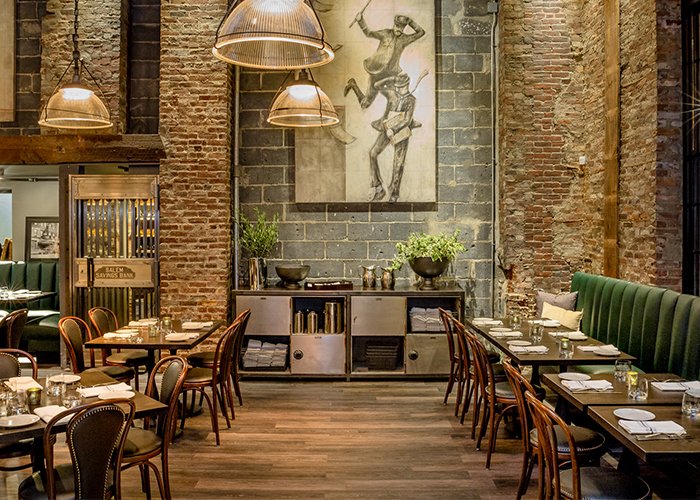
Although the signs of the coronavirus are still ever-present, diners once again have the ability to eat a meal they didn’t cook themselves, surrounded by more than just the people they live with.
Of course, that doesn’t mean the restaurant business is anywhere close to pre-COVID-19 levels.
Even where some form of in-person dining is possible, many consumers remain reluctant to return to restaurants. Nearly half (47%) of those consumers surveyed by Datassential in mid-June 2020 reported they’re still avoiding dining out. But the number of people who are eating at restaurants is slowly creeping upward.
When asked what they were most looking forward to doing once again social distancing restrictions were lifted, 33% of consumers surveyed for Datassential’s ONE TABLE initiative pointed to dining at their favorite sit-down restaurant, second only to visiting family members they haven’t been able to see while sheltering at home (36%).
While we’re still a long way away from pre-COVID-19 levels of occupancy, some form of limited indoor dining is permitted throughout the country. Restaurants are looking for creative options to afford social distancing and confidently communicate health and safety practices while continuing to promote their brand.
Flooring is one of the largest (at least in size) design choices in a commercial interior design project. Choosing the right flooring can significantly improve the customer experience. This point is highly regarded by the client and designer for lasting impressions.
As customers begin returning to restaurants for a dine-in experience those initial impressions are paramount. The client will make an immediate assessment of their surroundings.
First Impressions
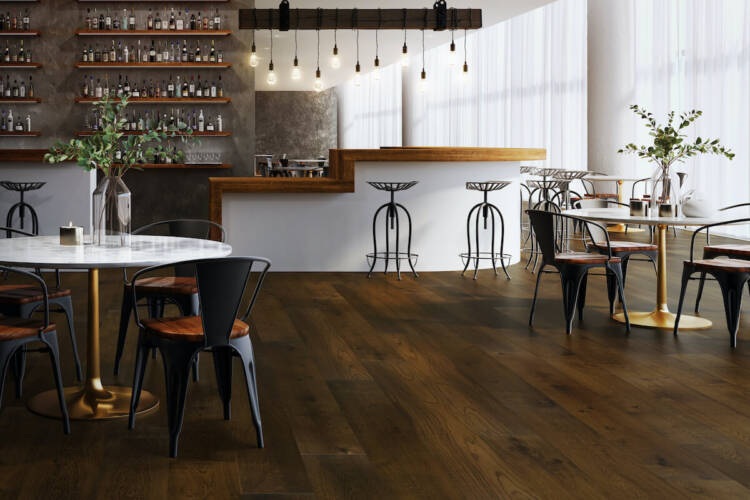 At this point, the food is not the only element informing a customer’s opinion during this return to in-person dining. In fact, the interior design of a restaurant, flooring included, will determine whether they feel safe and comfortable. If the floors are dirty, damaged or worn, customers may choose to retreat rather than dine in.
At this point, the food is not the only element informing a customer’s opinion during this return to in-person dining. In fact, the interior design of a restaurant, flooring included, will determine whether they feel safe and comfortable. If the floors are dirty, damaged or worn, customers may choose to retreat rather than dine in.
The type of flooring used within the restaurant industry must strike a careful balance of style and durability — and create an inviting environment.
LVT and hardwood are durable, sustainable flooring choices bound to make a lasting first impression. Hardwood is a timeless, classic solution that can add sophistication and style to any space. You can even combine hardwood and LVT in the same restaurant since Parterre’s tones and colors are complementary across all flooring products.
Before the coronavirus pandemic, it was recommended that restaurants give each seated dinner 15 square feet of space. During the pandemic, however, the World Health Organization (WHO) recommended this be increased to 27 square feet per dinner.
Restaurants responded with a variety of creative approaches in order to achieve this recommendation, whether it’s been the placement of separation panels, removal of tables/chairs, or occupying seats with mannequins (or in one noteworthy case, stuffed pandas.) Most of these choices have come with some associated cost and are short-term solutions.
Take the Ledger Restaurant & Bar in Salem, MA, for example. The unique space was the former home to the country’s second-ever chartered savings bank, which featured a large amount of concrete slab flooring. The restaurant’s ownership needed a flooring product that was quick to install and easy to maintain with cleanliness at the forefront — but also something that contributed to the staff’s ability to move tables quickly and social distance while maintaining their unique style.
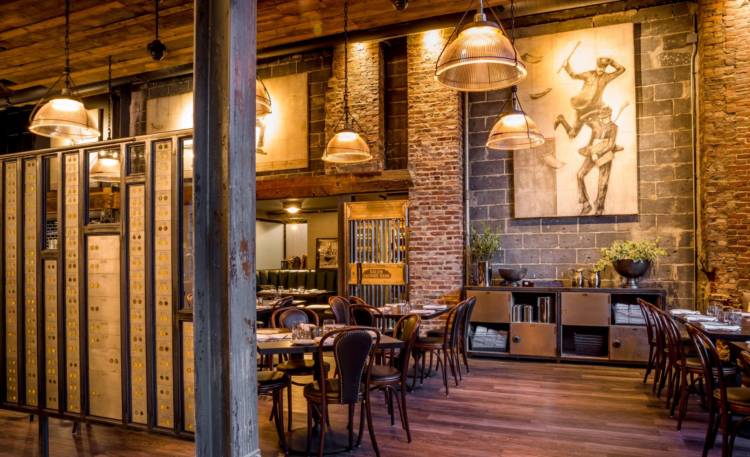
The design team in charge of the upgrade ultimately settled on several of Parterre’s LVT flooring options: Harbor Oak, a wood-looking flooring product from the InGrained Resilient Plank collection, for the private dining area; and Starry Oak, another wood-looking flooring option, for the main dining room areas. They also chose Ornamental Onyx, an elegant black stone look, and Classique Pure, a white and gray marble design, for a checkerboard pattern in a hallway space. All of these striking flooring selections contribute to a special cohesive design and style that greets customers when they first walk through the door.
Having beautiful, appropriate flooring will substantially increase the chances of impressing first-time and returning customers. Dining in a restaurant, whether it’s a fast food chain or a fine dining establishment, should be comfortable and hygienic. Cleanliness has never been more important.
- Maintenance is minimal: Restaurants are incredibly busy places, and as such require continual care and upkeep to ensure that they remain clean and presentable. It goes without saying that patrons expect cleanliness at all points in their experience. Resilient enough for almost any spill or mess, LVT and hardwood are both easy to clean and simple to maintain.
- Durability you can rely on: Flooring that experiences a high amount of foot traffic will undoubtedly sustain some wear in the form of scratches, scuffs and occasional gouges. This is just the nature of the hospitality business, and of flooring in general. This is why selecting the right type of flooring is crucial. Both LVT and engineered hardwood are both durable and versatile, meaning they can withstand most wear issues.
Lasting Impressions
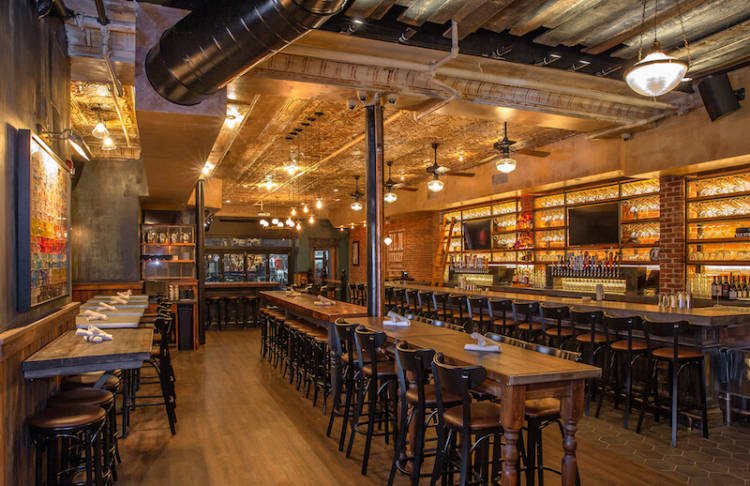
Restaurant spaces haven’t historically been built and designed for social distancing, and the advent of COVID-19 required a complete rethink.
LVT’s modular characteristics make it a great choice for redefining and planning spaces to visually represent social distancing guidelines. In addition to measured distancing, flooring styles can be configured to represent subtle directional lanes to move people through a space. Utilizing a selection of coordinating designs is another simple way to visually designate separate spaces.
The physical restaurant itself, above all visual representations, is part of its brand. The flooring should be on brand in both substance and style.
Whether you are working with a chic and modern or warm and traditional design, be sure that the LVT or hardwood style you choose corresponds with the feel of the brand, attracting customers. From neutral colors to bold, rich tones, LVT and hardwood can match the look and feel of your next project.
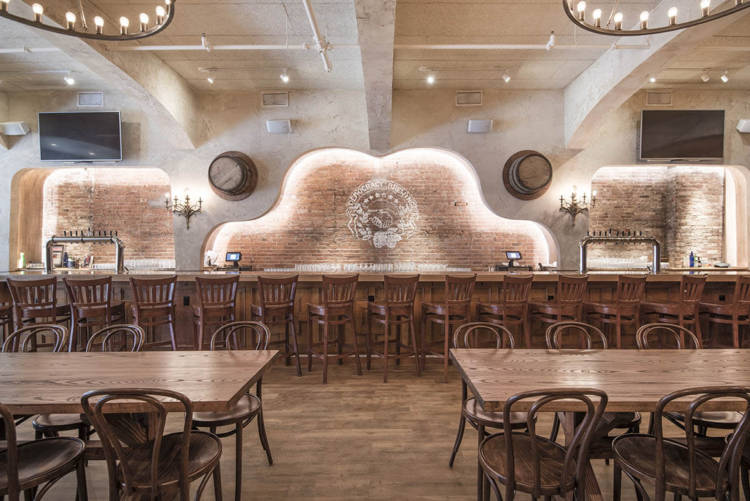
The first and last impressions will be the perfect balance of the form and function in your project, and providing the ideal flooring option for your restaurant will be critical.
Parterre is dedicated to industry-leading LVT and engineered hardwood for any commercial setting. Explore our site and reach out to us to help bring your ideas to life.
Marsha Weckenbrock Newton
Vice President Sales - West, Midwest, Canada
Sales leader with over 20+ years of expertise in the commercial flooring industry. In-depth knowledge of specifiers' (architects, designers, facility owners, etc.) needs, requirements, and concerns, and the ability to offer creative solutions to challenging opportunities.
Polished Concrete vs. Vinyl Flooring
Polished Concrete vs. Vinyl Flooring Polished concrete vs. vinyl flooring. It’s not an easy decision, considering both provide an excellent solution for commercial flooring. The look of concrete floors has been a growing trend for commercial interiors.
Chevron and Herringbone
Break the Pattern of Commercial Flooring You can add more flair to your commercial flooring by breaking from the look of traditional straight-line, square, and diagonal patterns. Eye-catching looks like chevron and herringbone will dot the designer landscape in 2024.